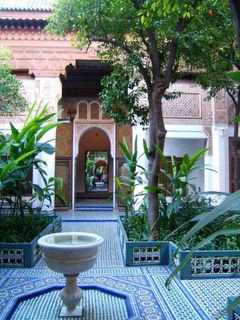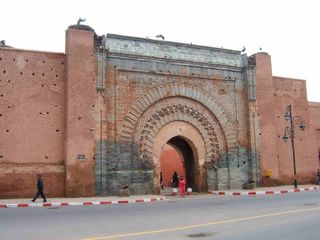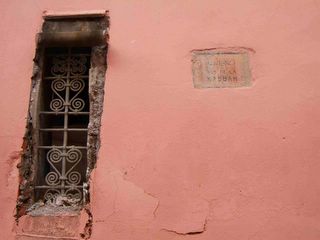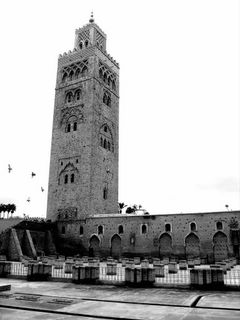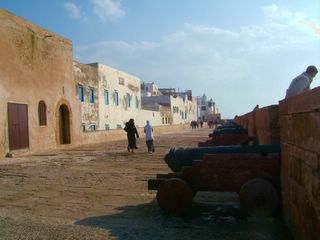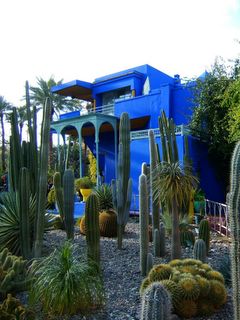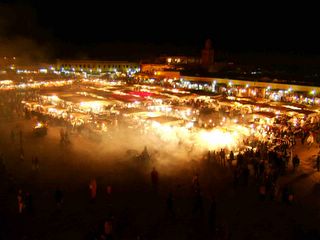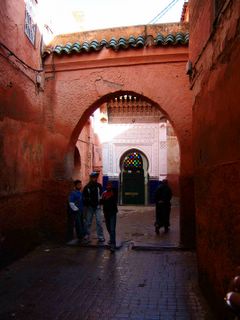Monday, February 27, 2006
El Bahia
“The beauty of Moroccan palaces is made up of details of ornament and refinements of sensuous delight too numerous to record, but to get an idea of their general character it is worth while to cross the Court of Cypresses at the Bahia and follow a series of low-studded passages that turn on themselves till they reach the centre of the labyrinth,” Edith Wharton, "In Morocco."
Edith would know. While in Marrakech the little minx stayed at the Bahia Palace. Ah, those were the days.
The palace, built in the 18th century, is a fairly recent addition to Marrakech. And it is stunning – room after room of intricately painted ceilings and doors, carved arches, and gardens twittering with song birds. The problem, however, is that so many buildings in Marrakech are voluptuously adorned. After only a few days, I began to feel overwhelmed and then blasé about it all. But not bored.
Sunday, February 26, 2006
Wednesday, February 22, 2006
Essaouria
“This must be the place where they empty all the old hourglasses.”
-Turkey Jackson, "Road to Morocco."
I was expecting a bit more in the way of sand as my colleague and I drove the winding highway to Essaouria. But instead we passed olive groves, green fields, and orange and yellow wildflowers. In fact, the only sand I saw that day was on the beach at Essaouria, a romantic beach town on the Atlantic shore. The package tourists tend to bypass Essaouria due to the rough ocean currents, which make swimming hazardous. (Three cheers for the currents, which send spectacular 15 and 20 foot waves crashing together AND keep out packaged tours!)
Essaouria is a charming town of blue doors, rugged battlements, and arched gates. At night, the town’s crooked streets are lit by tin lanterns punched with geometric shapes and lined with colored glass that cast fantastic shadows upon the white-washed walls. The souk is a relaxing change from Marrakech, with lower prices, less hassle, and minimal bargaining. If no deal is made -- no harm, no foul. It’s a far cry from Marrakech, where vendors get angry if you can’t or won’t meet their price.
Settled by Phoenicians, Romans, Portuguese, and finally Moroccans, most of what stands today in Essaouria was designed in the 18th century by a Frenchman hired by Sultan Sidi Mohammad bin Abdallah. This could explain Essaouria’s romance-saturated atmosphere. Or perhaps it was just because I was there on Valentines Day, and our hotel had decorated the dinner tables with heart shaped candle sconces and red roses.
As much as I enjoyed strolling its windy ramparts, Essaouria is a smallish place, and after an afternoon I felt we’d thoroughly explored the walled town. The next morning, we would return to Marrakech.
Tuesday, February 21, 2006
Jardin Majorelle
No visit to Marrakech is considered complete without a visit to at least one of its gardens. I'm not entirely sure why this is so -- perhaps the contrast of greenery against the bustle of the city, or greenery against the reddish stone of the medina -- but there are several famous gardens in Marrakech. I chose to visit the Jardin Majorelle. It's a newish garden for Marrakech, designed by French painter Jacques Majorelle around 1924. The brochure I picked up heralds it as "a place of rare individual expression and mystical force."
Riiiight.
The garden is pretty, though I think the botanical gardens at UC Riverside are more interesting. The Riverside gardens, however, lack the cachet of being located in Marrakech, designed by a French orientalist painter, and managed by a famous fashion designer, Yves Saint Laurent. They also lack an expensive gift shop.
On the other hand, Pirhanna Women and the Avocado Jungle of Death was filmed at the Riverside gardens.
It's a tough call.
Monday, February 20, 2006
"Like Webster's dictionary, we're Morocco bound." - Road to Morocco
Yesterday I returned from Morocco to Pakistan, where soldiers guard the major intersections of Lahore to prevent further rioting. I don’t want to think about that, so I’ll relive my Moroccan travelogue instead.
Day 1:Marrakech is one city that lives up to the romantic and mysterious images its name conjures up. Marrakech glows with every shade of red – from rosy pinks to burnt oranges. It’s the color of the Atlas mountains, which provide Morocco’s red rocks as well as its fertile plains. Moroccans in long coats with peaked hats drift through shady crimson-tinted alleys like jedi knights. It’s said that George Lucas’s planet Tatooine, from the original Star Wars, was inspired by Moroccan architecture and dress, and once I have the Star Wars comparison in my head I can’t get it out. So I tell all my colleagues and they are similarly stuck with the same surreal images.
Its old city (the medina) is a labyrinth of twisting, narrow streets designed to foil invaders and now confounding countless tourists. Maps aren’t much help when there are few street signs, and those that do exist are primarily in Arabic. So our first day we did what we’d absolutely been warned not to do, and hired a guide, Moustafa, off the street. He was the only one who approached me in my entire visit to Marrakech, and he was wonderful – a museum guide at loose ends while the museum was closed for renovations. He charged our group of 6 about seven dollars, and we ended up giving him double.
We visited some of the major tourist sites, then ended up in the famous Djmaa el Fna (the square of the dead, so named for executions which once took place there) plaza for dinner. Edith Wharton’s description of the nightly festival there when she visited in 1918 is still accurate. Storytellers, snake charmers, dancers, musicians, and thieves still prowl the square, entertaining Moroccan and tourist alike. In fact, there were only two differences I noted from Wharton’s description: more tourists, and the constant roar of motorcycles. The streets of the medina are so narrow that motorbike is the preferred mode of transportation, and during my stay in Marrakech I saw several pedestrians get clipped or knocked down by them.
Wednesday, February 08, 2006
Satire and the Muslim World
Some of you may have been wondering about the cartoon riots in Pakistan. I haven't been commenting on them because a) so much has already been said; and b) I haven't personally encountered any. People in Pakistan treat me the same as they ever have -- mostly well. I have had a few watercooler discussions with my Pakistani colleagues over the riots (when people start setting things on fire, they're rioting, not protesting, dammit!). My colleagues are uniformly unhappy with the cartoons but disgusted by the violence. I think/hope this is the silent majority, though it's unfortunate they remain silent. In the face of fundamentalist rage, however, I can't entirely blame them.
In the meantime, I'm keeping my head down and am soon leaving Pakistan for... Morocco.
Sunday, February 05, 2006
Help Afghan Kids
A buddy of mine, Master Sergeant Cesar Howell (GO ARMY!), has been working with some Afghan orphanages. CNN did a story on this project a couple months ago, and now he's got a website up for people interested in donating goods. Check it out at: http://www.help-afghan-kids.org/
Afghan orphanages are truly ghastly, and Cesar and his guys are making a real difference in these kids lives when they're not chasing down baddies. These guys are real heros, and I'm proud to know them.
Saturday, February 04, 2006
Victims and Villains
If Bombay, India, is "Bollywood," then its counterpart in Lahore is... wait for it...
"Lollywood."
I've been told Pakistani films don't measure up to their Indian counterparts, though I haven't seen enough to judge. I am, however, becoming somewhat of an authority on the local soap operas. I can't understand a word, but it doesn't matter because the actors are always replaying the same situations. I make up the dialog in my head anyway.
Cuckolded Wife: YOU??? And my HUSBAND?!
Cuckolded Wife's Best Friend: That's right! And your brother! And your cousin Akbar!
CW: Nooooooooooo!!!!
Pork is "haram" in Pakistan, but I've never seen so much hammy acting on TV. Dramatic pauses to rising music, a camera zoom on a shocked face, eyes widening with horror. Gasp! The plot lines and facial expressions are on par with the The Sheik, (one of the unintentionally funniest movies of all time), and I wonder if a local acting school was inspired by Rudolph Valentino.
Friday, February 03, 2006
Who's Barphlinker?
People that books made host becomes the cosmos
- Barphlinker
I don't know what it means either. But whatever Asian company produced my new desk lamp saw fit to write this in gold letters across the base of it. Is it some sort of Confucian, "sound of one hand clapping" puzzle? A secret Al Qaeda code?
What makes it all the more unusual is that all the words are spelled correctly.
I try rearranging the words in my spare time, and get even more bizaare combinations.
And who is Barphlinker?
Thursday, February 02, 2006
Top 10 Uses for a Headscarf (Dupatta)
10) Rappelling down the side of a burning Afghan wedding hall.
9) Tourniquet
8) Picnic blanket
7) Backdrop at a trade fair
6) Flagging down a rescue chopper
5) Bandito-style mask in a dust storm
4) Sarong/beach cover-up
3) Table cloth
2) Hand towel
1) Escaping a mine field (ask me how!)
Wednesday, February 01, 2006
Steve MacQueen
Here's a link to a recent BBC article about the murder of my colleague, Steve MacQueen, last year. The author was generous in saying that the Afghan authorities have stopped looking for his killers. You can't stop something you've never started.
http://news.bbc.co.uk/2/hi/south_asia/4662850.stm
Review: The Bookseller of Kabul
I'd been avoiding reading The Bookseller of Kabul, by Asne Sierstad. Though I'd heard good things about it, there are no happy stories written about Afghanistan, and frankly I see enough grief there not to want to engage in it during my leisure time. But when I picked up the book, I had a hard time putting it down.
A Norwegian journalist spent three months living with an Afghan family. She had initially befriended the patriarch, a wealthy and relatively well-educated Afghan bookseller who espoused women's rights and a host of other liberal ideas. But when she spent time in his home, she discovered that what he preached and what he practiced were two very different things. The book might better be titled "The Bookseller's Wives," because the family drama portrayed puts Dallas and Dynasty to shame. It's a great book, and the scenes it portrays feel very "real" to me.
The infuriated bookseller is now suing Sierstad over defamation of character, but after reading the book, I feel little sympathy for the man. And knowing what I do about Afghanistan, I believe Sierstad's portrayal is spot on.

